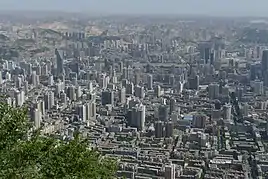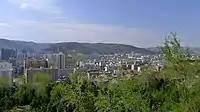Dingxi
定西市 | |
|---|---|
 Dingxi urban area (Anding District) | |
.png.webp) Location of Dingxi City jurisdiction in Gansu | |
 Dingxi Location of the city center in Gansu | |
| Coordinates (Dingxi municipal government): 35°36′29″N 104°35′31″E / 35.608°N 104.592°E | |
| Country | People's Republic of China |
| Province | Gansu |
| Municipal seat | Anding District |
| Area | |
| • Prefecture-level city | 19,609.24 km2 (7,571.17 sq mi) |
| • Urban | 4,225 km2 (1,631 sq mi) |
| • Metro | 4,225 km2 (1,631 sq mi) |
| Population (2020 census)[1] | |
| • Prefecture-level city | 2,524,097 |
| • Density | 130/km2 (330/sq mi) |
| • Urban | 422,383 |
| • Urban density | 100/km2 (260/sq mi) |
| • Metro | 422,383 |
| • Metro density | 100/km2 (260/sq mi) |
| Time zone | UTC+8 (China Standard) |
| ISO 3166 code | CN-GS-11 |
Dingxi (Chinese: 定西; pinyin: Dìngxī), also known as Longyou (Chinese: 陇右; pinyin: Lǒngyòu)[2] is a prefecture-level city in the southeast of Gansu province, People's Republic of China. As of the 2020 census, its population was 2,524,097 inhabitants, of which 422,383 lived in the built-up (or metro) area made of Anding urban district.
History
Dingxi was important in the development of some of China's earliest cultures, specifically along the Wei River, one of the Yellow River's biggest tributaries. Numerous Neolithic sites from various cultures are found throughout the area.[3]
A series of earthquakes in July 2013 killed at least 95 people and destroyed 120,000 homes.
Geography
Dingxi City is located in central Gansu province, 98 km (61 mi) east of Lanzhou, giving it the nickname the "eastern gateway". The Wei River, a tributary of the Yellow River flows through the district and provides it with the majority of its water. Dingxi is semi-arid, with little precipitation. Even though sunlight here can be intense, temperatures are generally cool. The surrounding terrain is mostly loess hills and ravines in the north and highlands in the south. The area is 20,300 km2 (7,800 sq mi).
After the Qianlong Emperor period (18th century), the land of Dingxi went from lush grasslands and forests to being severely deforested as a result of war, famines and overpopulation.[4]
Climate
Dingxi has a monsoon- influenced cool semi-arid climate (Köppen BSk) characterised like most of eastern Gansu by warm to very warm, humid summers and freezing, virtually snowless winters.
| Climate data for Dingxi (Anding District, 1991–2017 normals, extremes 1981–2010) | |||||||||||||
|---|---|---|---|---|---|---|---|---|---|---|---|---|---|
| Month | Jan | Feb | Mar | Apr | May | Jun | Jul | Aug | Sep | Oct | Nov | Dec | Year |
| Record high °C (°F) | 14.6 (58.3) |
20.3 (68.5) |
26.7 (80.1) |
29.6 (85.3) |
31.2 (88.2) |
32.0 (89.6) |
35.1 (95.2) |
34.2 (93.6) |
31.0 (87.8) |
24.9 (76.8) |
20.9 (69.6) |
15.4 (59.7) |
35.1 (95.2) |
| Mean daily maximum °C (°F) | 1.4 (34.5) |
4.8 (40.6) |
10.3 (50.5) |
16.8 (62.2) |
21.0 (69.8) |
24.4 (75.9) |
26.4 (79.5) |
25.1 (77.2) |
20.1 (68.2) |
14.3 (57.7) |
8.8 (47.8) |
3.4 (38.1) |
14.7 (58.5) |
| Daily mean °C (°F) | −6.5 (20.3) |
−2.2 (28.0) |
3.3 (37.9) |
9.5 (49.1) |
14.0 (57.2) |
17.8 (64.0) |
19.8 (67.6) |
18.8 (65.8) |
14.1 (57.4) |
8.1 (46.6) |
1.4 (34.5) |
−4.6 (23.7) |
7.8 (46.0) |
| Mean daily minimum °C (°F) | −12.3 (9.9) |
−7.6 (18.3) |
−2.0 (28.4) |
3.4 (38.1) |
7.8 (46.0) |
11.9 (53.4) |
14.4 (57.9) |
13.7 (56.7) |
9.5 (49.1) |
3.5 (38.3) |
−3.7 (25.3) |
−10.1 (13.8) |
2.4 (36.3) |
| Record low °C (°F) | −25.5 (−13.9) |
−22.1 (−7.8) |
−14.8 (5.4) |
−8.0 (17.6) |
−2.8 (27.0) |
2.6 (36.7) |
4.3 (39.7) |
5.0 (41.0) |
−1.3 (29.7) |
−10.4 (13.3) |
−18.1 (−0.6) |
−29.7 (−21.5) |
−29.7 (−21.5) |
| Average precipitation mm (inches) | 3.4 (0.13) |
4.6 (0.18) |
10.5 (0.41) |
23.5 (0.93) |
46.9 (1.85) |
53.3 (2.10) |
69.7 (2.74) |
79.9 (3.15) |
47.6 (1.87) |
29.6 (1.17) |
4.7 (0.19) |
1.4 (0.06) |
375.1 (14.78) |
| Average snowy days | 8.2 | 8.3 | 7.4 | 2.5 | 0.3 | 0 | 0 | 0 | 0 | 2 | 4.9 | 4.8 | 38.4 |
| Average relative humidity (%) | 59 | 58 | 54 | 51 | 54 | 60 | 65 | 68 | 72 | 71 | 64 | 58 | 61 |
| Mean monthly sunshine hours | 197.9 | 184.6 | 209.1 | 229 | 243 | 235.2 | 236.7 | 218.8 | 165.2 | 171.6 | 189 | 207.7 | 2,487.8 |
| Percent possible sunshine | 63 | 59 | 56 | 58 | 56 | 54 | 54 | 53 | 45 | 50 | 62 | 69 | 57 |
| Source: China Meteorological Administration[5][6] | |||||||||||||
Administration
Dingxi has 1 urban district, 6 counties, and 119 towns with a total population of 2,698,622.[7]
| Map | ||||||
|---|---|---|---|---|---|---|
| Name | Simplified Chinese | Hanyu Pinyin | Population (2010 census) |
Area (km²) | Density (/km²) | |
| City proper | ||||||
| Anding District | 安定区 | Āndìng Qū | 420,614 | 4,225 | 99.55 | |
| Rural | ||||||
| Tongwei County | 通渭县 | Tōngwèi Xiàn | 349,539 | 2,899 | 120.57 | |
| Longxi County | 陇西县 | Lǒngxī Xiàn | 453,259 | 2,657 | 170.59 | |
| Weiyuan County | 渭源县 | Wèiyuán Xiàn | 324,215 | 2,034 | 159.40 | |
| Lintao County | 临洮县 | Líntáo Xiàn | 507,386 | 2,851 | 177.97 | |
| Zhang County | 漳县 | Zhāng Xiàn | 192,957 | 2,164 | 89.17 | |
| Min County | 岷县 | Mín Xiàn | 450,654 | 3,500 | 128.76 | |
Economy
Dingxi has been one of the most poverty-stricken regions in Gansu province and China as a whole.[8] Up to 1999, some citizens still lacked food and clothing. Although most of Gansu is arid, in other regions of the province a large portion of farmland is irrigated, whereas in Dingxi this was not the case.[9] Especially after the 1960s, the agricultural output of Dingxi plummeted due to land degradation.[10]
Agriculture and natural resource based industries are the key to Dingxi's economy. There are more than 300 different kinds of Chinese medicinal plants and herbs found in the area. Dingxi's Anding County is China's number one grower of yams. Zanthoxylum (also called Sichuan Pepper or prickly ash fruit), walnuts, wild apricots, and other fruit are some of Dingxi's famous dried exports. Potato is an important crop, and Dingxi has been described as the 'Potato Capital of China'.[11]
Culture
The local Dingxi dialect of Central Plains Mandarin has only three tones instead of the normal four.[12]
Food
Transportation
See also
- Xihaigu, region in Ningxia with similar landscape and economic issues
References
- ↑ "China: Gānsù (Prefectures, Cities, Districts and Counties) - Population Statistics, Charts and Map".
- ↑ "甘肃定西邀客乡村游:黄土高原赏"国色天香"回归田园-中新网". www.chinanews.com. Retrieved 2021-04-21.
- ↑ 中国·定西党政网 历史沿革. Dingxi People's Government.
- ↑ Hao, Ni. Travel Guide of Gansu. DeepLogic.
- ↑ 中国气象数据网 – WeatherBk Data (in Simplified Chinese). China Meteorological Administration. Retrieved 24 September 2023.
- ↑ 中国气象数据网 (in Simplified Chinese). China Meteorological Administration. Retrieved 24 September 2023.
- ↑ Main data bulletin of the sixth national census in 2010 Archived 2014-11-29 at the Wayback Machine, 2011-05-09 (in Chinese)
- ↑ 中国·定西党政网 亲切关怀. Dingxi People's Government.
- ↑ Far Eastern Economic Review. Review Publishing Company Limited.
- ↑ "China - Strategies for reducing poverty in the 1990s". World Bank. Retrieved 2021-04-21.
- ↑ 中国·定西党政网 定西简介. Dingxi People's Government.
- ↑ Wang, Menghuan; Ma, Shuzhen; Hu, Axu (2021). Tavana, Madjid; Nedjah, Nadia; Alhajj, Reda (eds.). "Experimental Study on Citation Tone of Dingxi Dialect in Gansu Province". Emerging Trends in Intelligent and Interactive Systems and Applications. Advances in Intelligent Systems and Computing. Cham: Springer International Publishing. 1304: 340–345. doi:10.1007/978-3-030-63784-2_43. ISBN 978-3-030-63784-2. S2CID 230557863.
- ↑ "定西特色小吃有哪些 甘肃定西特产 - 天气加". Archived from the original on 2019-10-30.
External links
- Dingxi Official Website (in Chinese)




